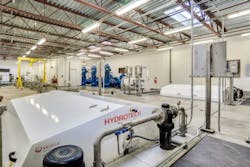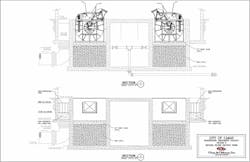When Performance Trumps Space Limitations With Filter Discs
Bob Busch is wastewater treatment facility operations supervisor for the city of Camas. Busch can be reached at [email protected]. Bill Reilly is owner of Wm. H. Reilly & Co. Reilly can be reached at [email protected]. Tabitha Atkinson is marketing manager for Veolia Water Technologies. Atkinson can be reached at [email protected].
undefinedThe City of Camas, Washington’s origins began more than 100 years ago as a paper-mill town along the Columbia River, located in the eastern hills of Clark County in Southwest Washington.
The city’s activated sludge, secondary wastewater treatment facility (WWTF) serves approximately 22,000 residents and has a maximum monthly flow capacity of 6 million gallons per day (mgd). The WWTF personnel perform operation and maintenance of the plant for the treatment of domestic, commercial and industrial wastewater. They also operate and maintain 28 pumping stations in the wastewater collection system.
The plant’s main components consist of a headworks with primary influent screens, two primary clarifiers, three aeration basins, three secondary clarifiers, two effluent filters, low pressure ultra-violet disinfection, two aerobic digesters and a biosolids dryer. The treated effluent from the WWTF is discharged to the Columbia River.
NPDES TSS Permit Requirements
The city of Camas NPDES permit requires total suspended solids (TSS) removal on a monthly average of <20 mg/L effluent TSS concentration and a monthly average TSS discharge of no more than 1,017 pounds per day. The monthly average TSS removal must be 74% or greater.
The city has a relaxed requirement from the Washington State Department of Ecology for TSS removal due to its unique circumstances that include significant contributions from septic tank effluent pumping/gravity STEP/STEG systems and dilute industrial flows that combine with inflow/infiltration during wet weather that is far more dilute than typical municipal wastewater treatment plants. Because of this, the state regulators require the city to operate the filters to achieve adequate TSS removal to maintain the 74% removal limit in the permit in lieu of the standard 85% removal for most municipal treatment plants.
Pile Cloth Filter Difficulties
Effluent pile cloth style disk filters were installed to ensure the city could meet the TSS removal requirements in its NPDES permit. Since the effluent filters have not been operational for several years due to maintenance issues, the city has experienced violations of the TSS removal requirements in their NPDES permit.
The WWTF operators reported a number of problems with operating the pile cloth style disk filters. The most prominent issue was the buildup of biological growth on the interior of the filter fabric, which occurs because the backwash system consists only of intermittent flow reversal through the fabric and does not include spray washing. The excessive fouling over time resulted in reduced hydraulic capacity and the inability to keep the pile cloth disk filters operational. Other reported issues include inoperative valves, deterioration of the backwash pumps, and an inability to replace outdated parts.
To meet the effluent requirements, the city of Camas Wastewater Treatment Facility (WWTF) replaced its existing cloth media disk filters. At the same time, it was necessary for any filter upgrade to fit within the space used by the existing filters. The site needed a solution that would allow workers to easily maintain the capacity and performance of the filter media while also fitting within the existing footprint and hydraulic profile of the existing filters.
Evaluating Alternative Filtration Solutions
The city of Camas engaged the engineering firm, Gray & Osborne, to evaluate potential alternatives to either rehabilitate or replace the existing effluent filter. After extensive evaluation and discussions with the plant and city personnel, Gray & Osborne and the city determined that the existing filters should be replaced.
The evaluation by Gray & Osborne looked at a number of different filter retrofit alternatives including gravity media filters, drum filters, alternative design pile cloth filters, stainless steel mesh filters and the Veolia Hydrotech Discfilter.
Several of the alternatives were eliminated because they would not be able to provide the necessary capacity within the existing footprint. The pile cloth alternatives were eliminated due to the experience with the existing pile cloth design’s ongoing fouling, operations and maintenance issues. An overall operation and cost analysis was then conducted on the remaining potential filtration solutions.
The comparison resulted in identifying the Veolia Hydrotech Discfilter for the Camas WWTF retrofit. It provided the necessary future capacity in the existing footprint, had strong performance and reliability during a demonstration pilot test, and was the most cost effective of the choices. Based on this, Gray and Osborne then completed the design of the filter upgrade and retrofit project based on Veolia’s Hydrotech Discfilter system as part of the Phase 2B improvements project.
The city subsequently went out for construction bids to complete the project. As part of the contract with the general contractor, Veolia furnished two of the Discfilter units along with the Discfilter control system. The system is designed to treat a peak flow of 6 mgd and provide an effluent with total suspended solids concentration of ≤10 mg/L.
The compact footprint and low headloss of the system allowed for installation within the footprint of the facility’s existing cloth media filtration system. The Hydrotech media also offers easy cleaning and simple maintenance. The plant’s existing filters were removed from service and demolished.
Modifications for Installation
Only minor modifications were made to the filter basins to allow for the installation of the new discfilters. The new system allowed the site to use less space than the previous filters at the site, allowing for better accessibility to the units for O&M purposes.
The new discfilters consist of two units, each with 12 discs and 723 square feet of filter area and 470 square feet of submerged filter area. They operate at a peak hydraulic loading of 4.43 gallons per minute per square foot. The influent to the filters flows by gravity into the partially submerged filter discs from the center drum. Flow is continuous, even during backwash cycles.
The new filters also incorporate an Automatic Cleaning System (ACS). The ACS allows the city to easily clean the discfilter media and is set up to allow the operators at the WWTF to quickly connect the ACS to the filters. The control system automatically controls the supplemental chemical cleaning process to remove any fouling agents or chemicals. This ultimately allows the WWTP to maintain optimal capacity of the filter media.
Filter Discs Aid TSS Compliance
The final proof of the successful retrofit and upgrade project is in the overall performance of the new Veolia filtration system.
The filter retrofit project was completed in 2013 and put into service at that time. The new Hydrotech Discfilter system has been running effectively at the city of Camas Wastewater Treatment Plant since commissioning at that time. The staff reports that the Discfilters have proven to be reliable and easy to operate and maintain.
The filters have also shown to be effective and reliable in meeting the TSS effluent performance requirements while also maintaining the required design flow capacity necessary to avoid bypassing of untreated effluent. All in all, the filters were a successful upgrade for the Camas WWTF.

